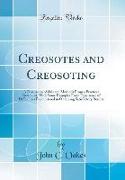Creosotes and Creosoting
BücherAngebote / Angebote:
Excerpt from Creosotes and Creosoting: A Discussion of Oils and Methods From a Practical Viewpoint, With Some Examples From Experience of Difficulties Encountered in Obtaining Satisfactory ResultsWith timber of small dimensions thorough penetration has been obtained by the above method, and it is claimed that the strength of the timber has been increased rather than diminished, owing perhaps to the fact that the wood cells have each received a thin coating of creosote, which, upon drying, may act to strengthen the cell walls. So far as is known, timber treated by this latter method has not been experimented with in marine work, but it is almost certain that it would not resist the teredo. It is doubtful to my mind if the process has very great preservative value when used for timber to be exposed to the elements, because of the porous and spongy condition of the timber after treatment. It is being used by the Santa Fe Railroad Company in the treatment of their ties. Sufficient time, however, has not elapsed since they began its use to show definite results.Another point unfavorable to this process is that the timber being cold and the oil hot, or at least warm, a portion of the heavy constituents of the oil are crystallized or coagulated and remain in the wood. For this reason, principally, the Santa Fe Railroad uses the German oil, which is deficient in naphthalene and therefore loses less by crystallization than would other oils. After each treatment the oil becomes less and less a preservative for this reason, and besides it is adulterated by the sap, resin, etc., withdrawn from the timber."It is argued that inasmuch as the timber is not steamed, the hot oil dissolves and liquifies the natural substances of the wood - i.e., resin, sap, etc. - and in drawing the air and oil out, when the vacuum pump is applied the excess oil is necessarily greatly adulterated, and its preservative qualities impoverished, and after this emulsion is used over and over a few times, while it may have the semblance of creosote, it is no longer a timber preservative. It will be seen that timber treated with an emulsion of creosote, sap, resin, and water, with a great proportion of the preservative qualities of the creosote lost, through evaporation and volatilization, by reason of frequent reheating of the emulsion, will not endure much longer than timber in its green state."For these reasons plants using this process are liable to have an adulterated oil in their tanks.Bethel Process.The "Bethel" process is the one of particular interest at the present time in connection with marine construction, and is the one to which the following statements apply unless otherwise indicated.About the PublisherForgotten Books publishes hundreds of thousands of rare and classic books. Find more at www.forgottenbooks.comThis book is a reproduction of an important historical work. Forgotten Books uses state-of-the-art technology to digitally reconstruct the work, preserving the original format whilst repairing imperfections present in the aged copy. In rare cases, an imperfection in the original, such as a blemish or missing page, may be replicated in our edition. We do, however, repair the vast majority of imperfections successfully, any imperfections that remain are intentionally left to preserve the state of such historical works.
Folgt in ca. 10 Arbeitstagen




